|
In memory of those who fought for our freedom Herinnering aan onze bevrijders
| Bevrijding van Dieteren in tweede Wereldoorlog. Zoals U wellicht weet is Dieteren bevrijd op 16 januari 1945 door de Engelsen. 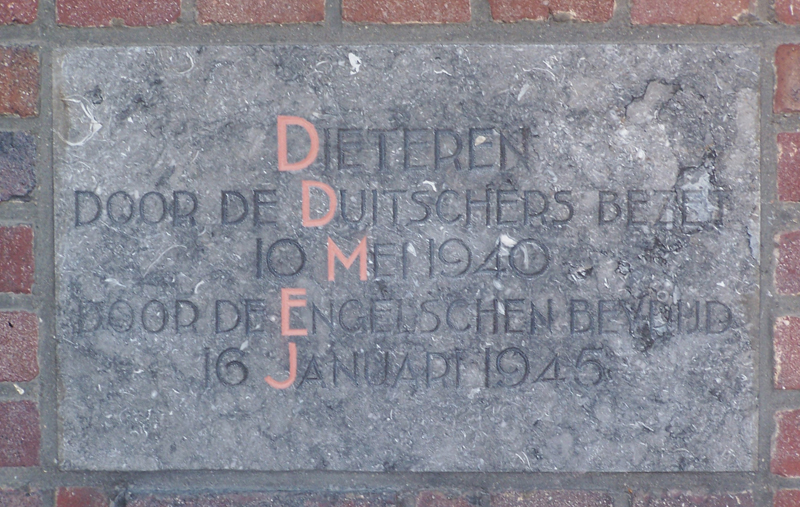 Gedenksteen ingemetseld bij ingang St. Stephanuskerk Dieteren. Het opschrift luid: Dieteren Door de Duitschers bezet 10 mei 1940 Door de Engelschen bevrijd 16 januari 1945 Tijdens de bevrijding van Dieteren, Susteren en Echt zijn aan geallieerde zijde slachtoffers gevallen, sommige gesneuvelden zijn in Dieteren tijdelijk begraven geweest. Meer hierover is te lezen op: deze pagina. Om meer te weten over wie dat waren en welke eenheid Dieteren nu bevrijd had heb ik mij wat verder verdiept in deze zaak en gaandeweg wat informatie op internet gevonden. Via fora contact gelegd met onderzoekers en uiteindelijk heb ik ook kopieën verkregen van oorlogs dagboeken (War Diary) van enkele eenheden. Wat mij opvalt in de verslaglegging is dat ze de operatie technisch goed beschrijven maar in mijn ogen de zware omstandigheden van vijandelijke beschietingen nogal luchtig opnemen. Terwijl dit in de enkele persoonlijke beschrijvingen van militairen die ik gelezen heb, omschreven wordt als de hel op aarde! Na de landing in Normandië verliep de bevrijding door Frankrijk en België gestaag tot men in september aankwam in Sittard en omgeving. Sittard, Nieuwstadt, Born en Roosteren werden bevrijd en toen hield men halt. Hierdoor kwam Dieteren en Susteren in het frontgebied te liggen. De mensen hier waren al in afwachting van hun bevrijding maar dit mocht helaas nog niet zo zijn. Ze zouden zelfs nog moeten evacueren en nog veel oorlogsgweld zoals bombardementen en granaatvuur moeten ondergaan. Om het mogelijk te maken dat het bevrijdingsleger over de Rijn richting Berlijn te laten trekken moest eerst de Roerdriehoek worden bevrijd. Hiertoe had men een plan van aanpak bedacht dat de codenaam Operation Blackcock kreeg. Dit plan was weer onderverdeeld in deeloperaties met de codenamen Angel, Bear, Crown, Dolphin, Eagle, Fleece, Globe, Hart, Jug en Kettle. 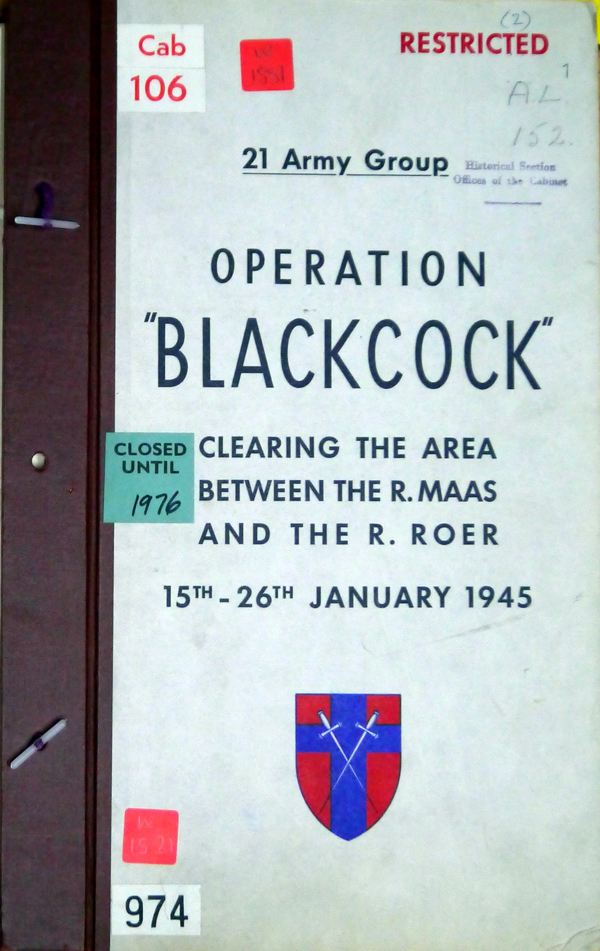 Operation Blackcock 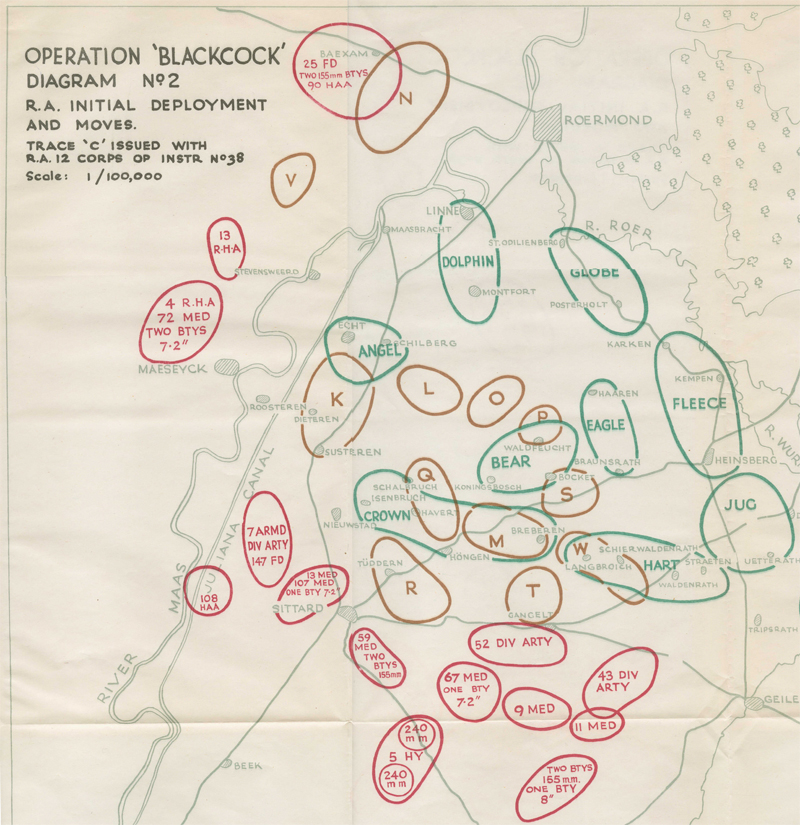 Kaart met onderdelen operatie Blackcock Voor Dieteren was Angel van belang deze was verder weer opgedeeld in 3 fases namelijk, Angel I met als doel een brug over de Vloedbeek (nu bekend als Vloedgraaf) te maken en het bevrijden van Dieteren. Angel II met als doel het bevrijden van Schilberg, Echt en omgeving. Angel III met als doel het bevrijden van Susteren en de route Sittard-Schilberg richting Roermond te openen. Angel werd uitgevoerd door 131 Lorried Infantry Brigade met de eenheden: 1/5 Queens Royal Regiment, 2 Devons, 9th Durham light Infantry, 1 R Tks, One sqn less one tp Lothian and BORDER YEO (Flails), One sqn 141 RAC (Crocodiles), 258 Bty NY, Two tps 1 Cdn Armd Personnel Carrier Regt (Kangaroos), One TCL. Voordat operatie Blackcock uitgevoerd kon worden moest eerst Baakhoven ingenomen worden dit werd vanuit Gebroek gedaan door 1/5 Queens. Vervolgens kon de 9th DLI 16 januari vanuit Baakhoven over Vloedgraaf met ladders naar brug bij Dieterdermolen die weliswaar met springstof was geladen, maar nog intact was door naar Dieteren welke snel ingenomen werd en waar ongeveer 25 Duitsers krijgsgevangen werden genomen. Hiermee was Angel I bewerkstelligd De 1/5 Queens en 2nd Devons volgden de DLI en omdat er moeilijkheden waren voor tanks om de Vloedgraaf over te komen, werd besloten dat eerst Angel III werd uitgevoerd door de 1/5 Queens, dit werd een zwaar gevecht tot artillerie en uiteindelijk tankregiment er zich mee konden bemoeien. De 2dn Devons waren toen ook inmiddels door Dieteren getrokken richting Ophoven om Angel II uit te voeren dus de bevrijding van Echt en Schilberg. Het was dus continu een samenwerking tussen de eenheden maar we kunnen stellen dat 9th DLI Dieteren heeft bevrijd en 1/5the Queens Susteren. Als we oorlogsdagboek (War Diary) van 9th Durham Light Infantry bekijken kan ik daar het volgende uithalen. Voorafgaand aan operatie Blackcock bereidde de eenheid zich voor op het passeren van de beken door te oefenen met verschillende typen bruggen en ladders bij Millen en de omgeving van Geleen. Tijdens de operatie werden ook enkele vlegeltanks ingezet, omdat tussen Baakhoven en Dieteren mijnenvelden door de Duitsers waren aangelegd. Een vlegeltank reed vermoedelijk schuin over de zojuist gemaakte brug en deze kantelde samen met de tank in de Geleenbeek, waardoor er later weer een andere brug gelegd moest worden. Ook gebruikten de Duitsers als verdediging veel Spandau- en mortiervuur. De omstandigheden waren echt winters, het was een vorstperiode met soms dooi, er lag een laagje sneeuw en het was mistig. Op de vroege ochtend van 16 januari 1945 startte de operatie door 4 Coys (A, B, C en D) van de Durham Ligth Infantry aangevuld met 1 Coy(=Company) (Q) van de 1/5 Queens. Vertrekpunt was Gebroek en via Baakhoven trok men richting de Vloedgraaf. Hier moest men noodbruggen aanleggen onder hevig vuur van de Duitsers. Als eerste werden met ladders en balken provisorische loopbruggen gecreëerd waarover de infanterie al snel kon oversteken. Toen kon men naar de brug over de Rode Beek bij de Dieterdermolen oprukken en deze nog intact innemen. Hierbij werden de aanwezige Duitse soldaten gevangen genomen. 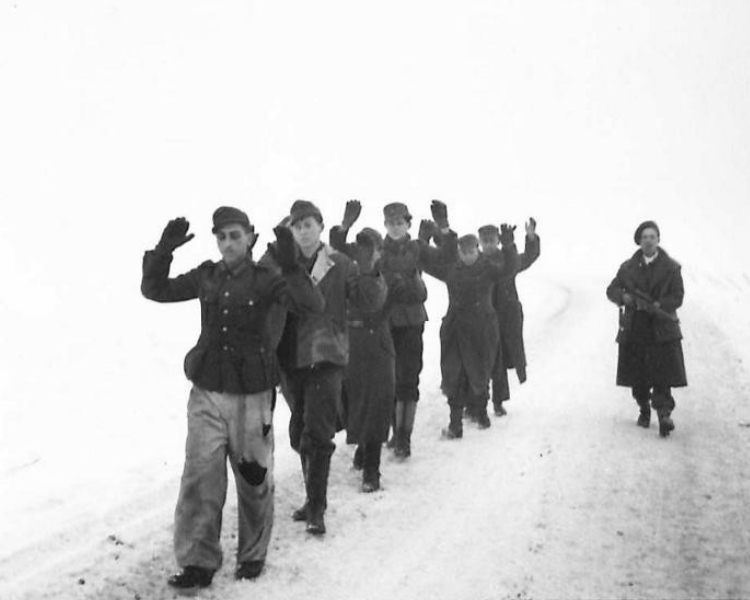 Eerste bij Baakhoven gevangen genomen soldaten. Foto: Sgt. Smith 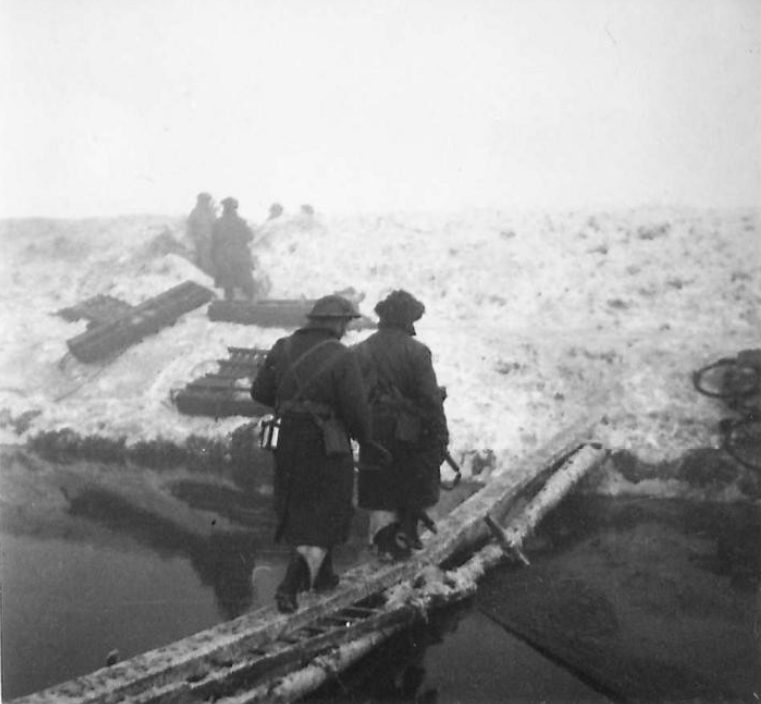 Mannen van de 9th DLI steken de Vloedgraaf over even na 8 uur in de morgen. Foto: Sgt. Smith 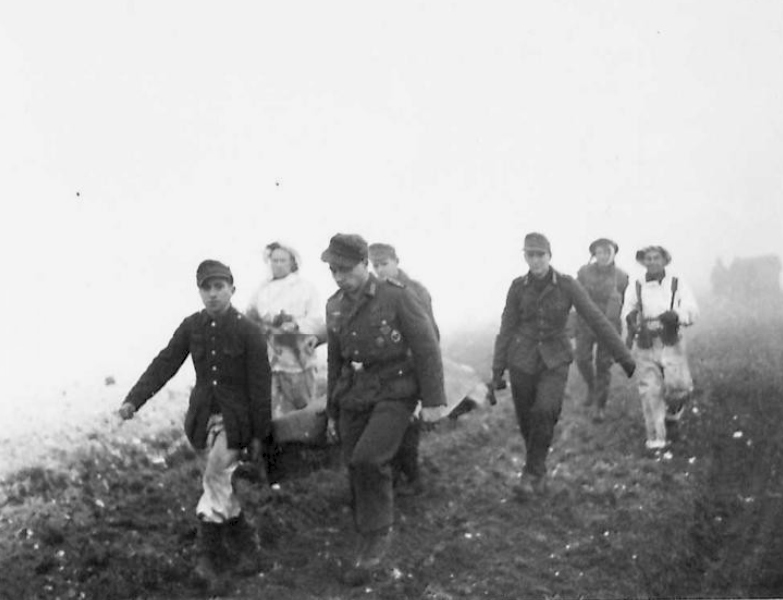 Eerste in Dieteren gevangen genomen soldaten dragen hun eigen gewonden en worden binnengebracht door 9th DLI. Foto: Sgt. Smith Spoedig daarna bereiken achtereenvolgens A en B Coys het dorp Dieteren en vrij snel weten ze de daar aanwezige Duitse soldaten gevangen te nemen samen met D Coy. Q Coy gaat richting hun doel de ‘Concrete Works’ dit is de steenfabriek/ringoven die destijds op het huidige Industrieterrein Dieterweg gelegen was. C Coy en HQ gaan nu ook naar Dieteren en arriveren daar omstreeks 10.30 uur. Ik beschouw dit moment dan ook het tijdstip waarop Dieteren was bevrijd. Met granaatvuur op Dieteren probeerden de Duitsers om de opmars tot staan te brengen. Ondertussen waren de Britten er in geslaagd een schaarbrug over de Vloedgraaf te plaatsen. 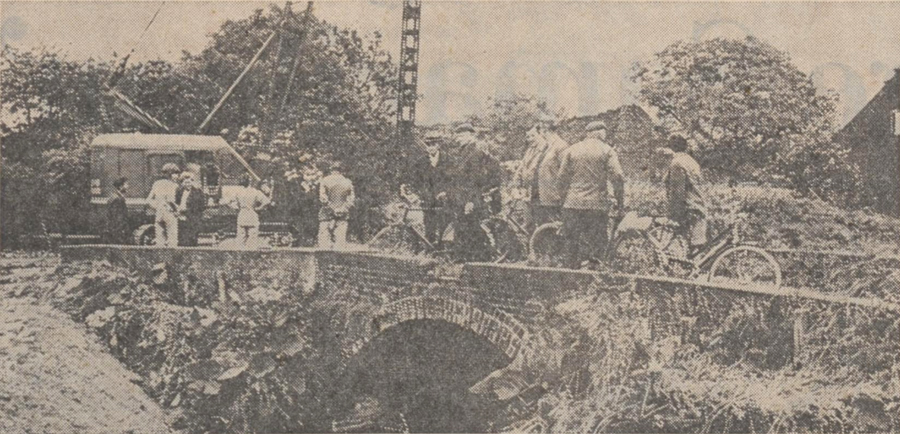 Eeuwen oude brug over Rode beek anno 1971 toen deze werd gesloopt. In januari 1945 reden hier de tanks overheen van het Britse bevrijdingsleger. Bron: Limbursch dagblad 11 juni 1971 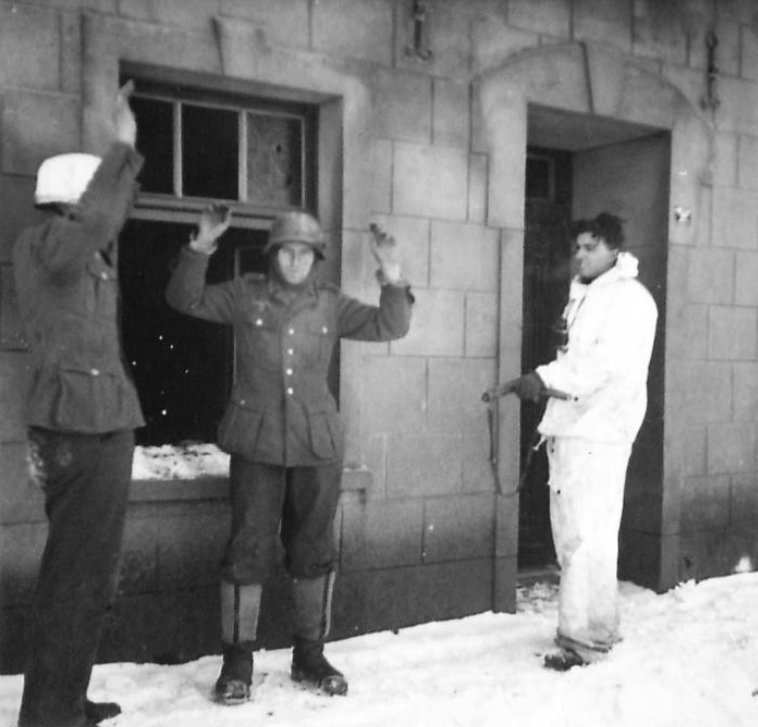 Duitsers in Dieteren geven zich over. Foto: Sgt. Smith 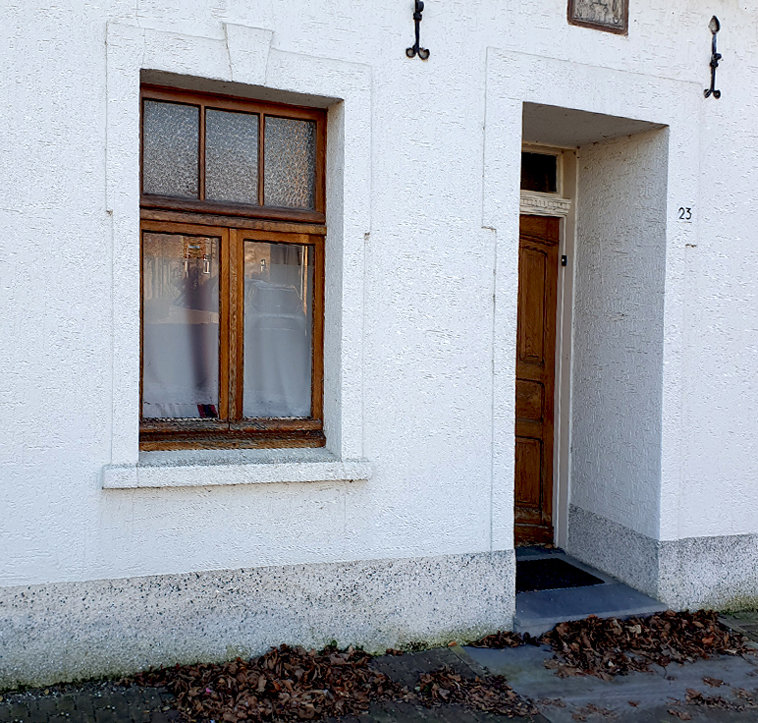 Zelfde lokatie Dieteren “op de Groos” anno 2024. 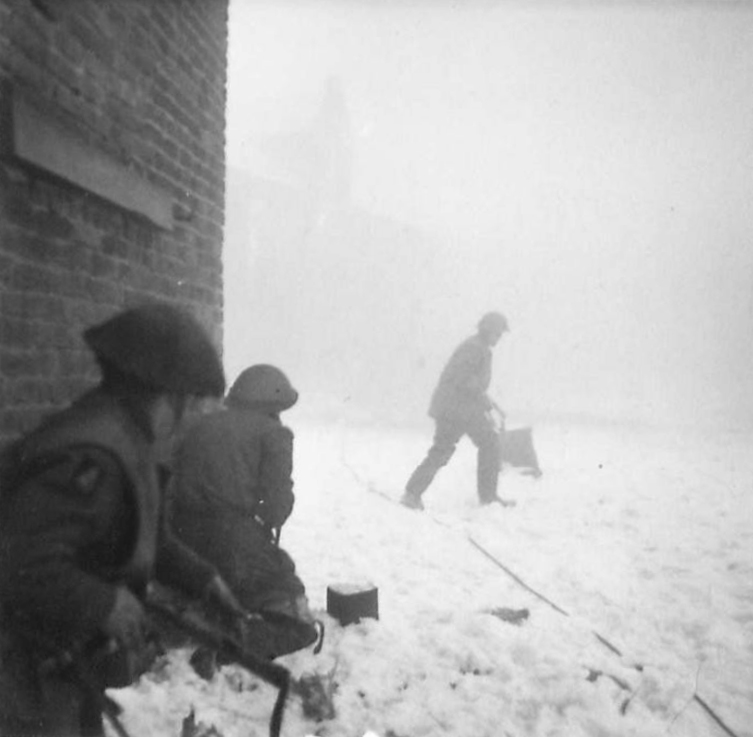 Mannen van de 9th DLI in Dieteren “op de Heuvel”. Foto: Sgt. Smith 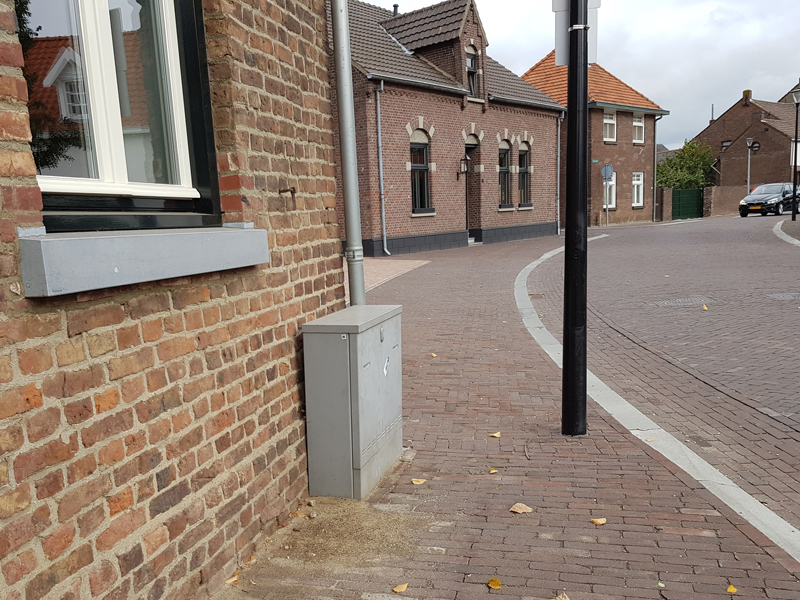 Zelfde lokatie Dieteren “op de Heuvel” anno 2019. De volgende dag trokken eenheden van 1/5 Queens Susteren binnen, ze kregen hier echter veel weerstand van de Duitsers en vanuit het oosten kwamen ook nog 7 Duitse tanks aan die verschillende huizen in puin schoten wat de toestand voor de Queens kritiek maakte. Ondertussen was de C Coy van de 9th DLI richting de brug bij de Dieterdermolen om de toestand daar te stabiliseren. Precies op dat moment kwamen ze een Duitse eenheid tegen die een tegenaanval wilde inzetten. De DLI vroeg om artillerie ondersteuning waarbij de Duitsers verrast werden, een gevangen genomen Duitse soldaat werd teruggestuurd naar zijn eenheid met de boodschap dat zij zich moesten overgeven. Toen zij dit niet deden startte men wederom het artillerievuur, nu konden 8 Duitse soldaten gevangen worden genomen. Tanks van een squadron 1 R.T.R. kwamen nu door Dieteren richting Susteren om de Queens daar te helpen. Ook D Coy van 9th DLI gingen naar Susteren als versterking voor de Queens welke op het eind van de middag melden dat ze Susteren tot aan de spoorweg in handen hadden. Van de ondertussen gearriveerde 2 DEVONS ondersteund door 1 R.T.R. ging een gedeelte vanuit Dieteren oostwaarts en bij de rijksweg noordwaarts, het andere deel ging binnendoor van Dieteren naar Ophoven en Echt. De diverse Coys van 9th DLI maakten zich in gereedheid om de 2 DEVONS te assisteren. Dit kon de volgende dag 18 januari toen de 5 K.O.S.B. in Dieteren arriveerden en ook nog Oud Roosteren innamen. 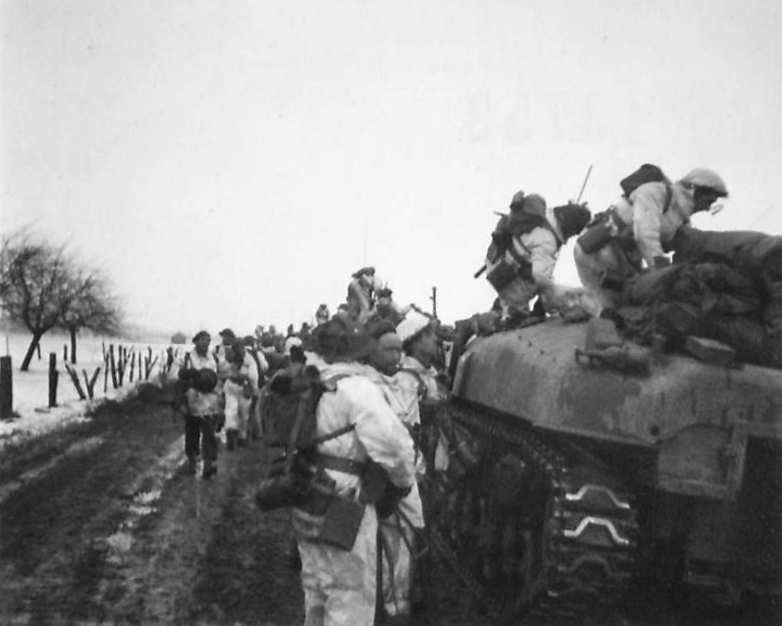 Troepen 9th DLI gaan met Kangaroos op weg van Dieteren naar Echt (19 januari). Foto: Sgt. Smith 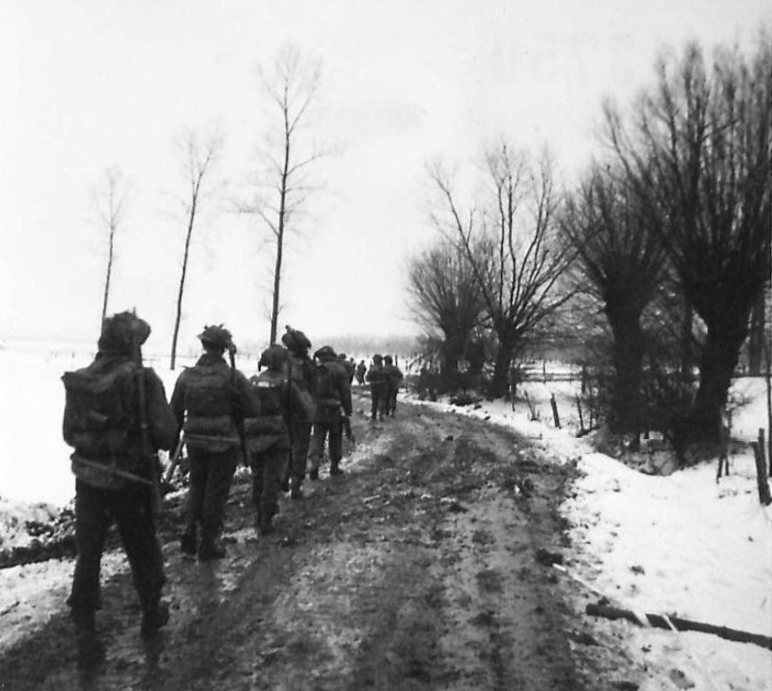 Troepen 5 K.O.S.B. te voet op weg van Dieteren naar Echt (19 januari). Foto: Sgt. Smith 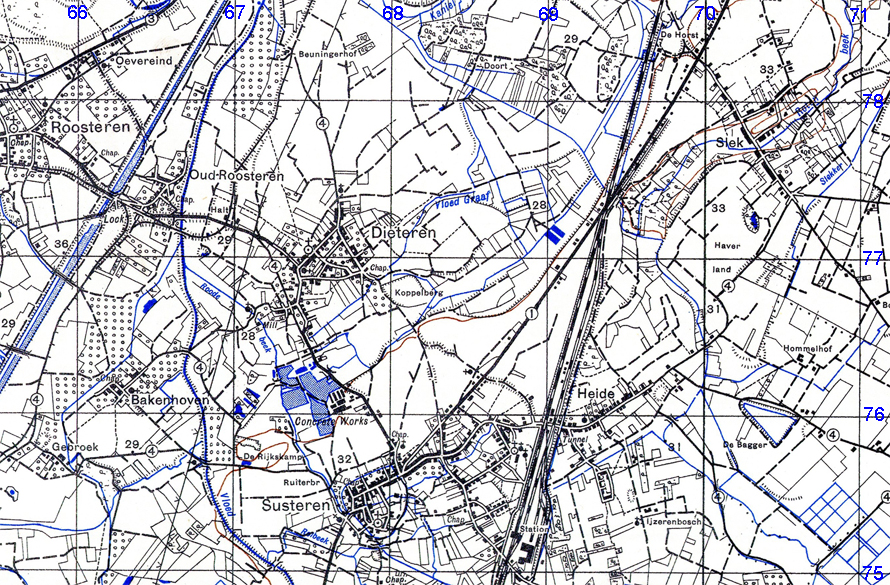 Kaart van Britten met het gebied Dieteren voorzien van coördinaten zoals die ook voorkomen in het verslag hieronder. Verslag(War Diary) van de 9th DLI die de operatie in Dieteren beschrijft
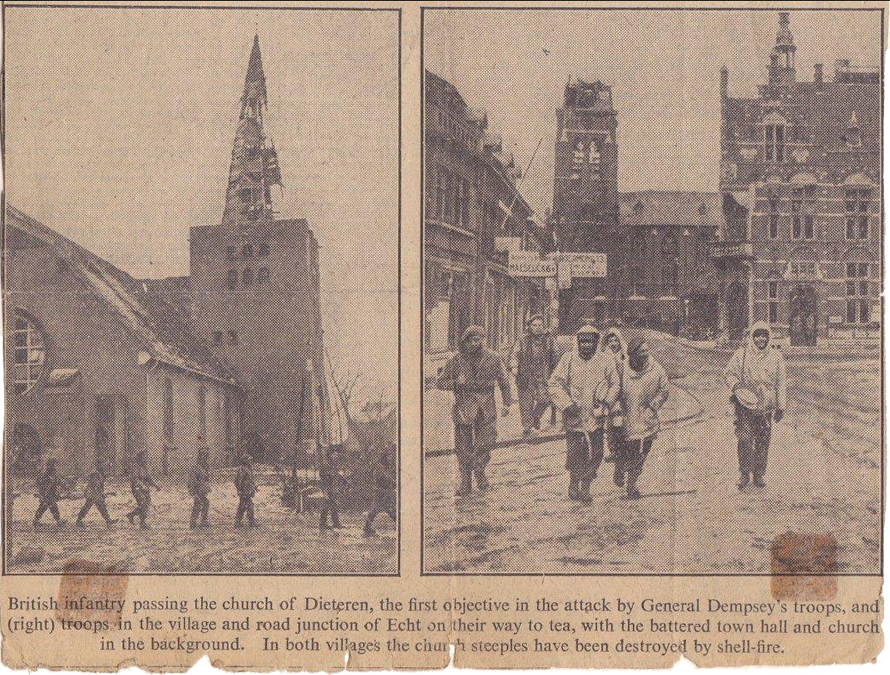 Fragment uit een Engelse krant In een publicatie van “Churchill's Desert Rats” lees ik: XII Corps was given the task of clearing 176th and 183rd German Infantry Divisions, which had dug-in SPs and 88mms, from a triangle formed by the rivers Roer, Wurm and Maas - an advance of 12 miles in a north-east direction. The Desert Rats were on the left flank with 131st Brigade attacking northwards to secure Echt, Schilberg and Susteren. Then the plan was for 22nd Armoured Brigade to break through northwards to Montfort and St Odilienburg. If the ground remained frozen the operation was possible, but if a thaw turned deep ditches, canals and water meadows into a quagmire then it would be extremely difficult. Much of 52nd Lowland Division was under command - their 155th Infantry Brigade plus 8th Armoured Brigade. The first task on 13 January was the capture of Bakenhoven, a small village on the west side of the Vloed Beek stream. 1 /5th Queens ‘D’ Company did this after Lothians and Border Yeomanry flail tanks had cleared the minefields in the way, and after a heavy RHA barrage. The extrovert Canloan Major C.V. Lilley commanded ‘D’ Company, which repulsed a determined counter-attack by white-suited German infantry. This caused seventeen casualties but twenty-seven enemy dead were counted on the frozen ground. Now thick freezing fog descended on the battlefield and D-Day was set for dawn of 16 January. The Durhams crossed the 20-ft Vloed Beek at 0730 hrs using carefully made ladders. By 1030 hrs a bridge had been captured over the second dyke in front of Dieteren and many prisoners taken. Derrick Watson wrote: Rather apologetically my CO (Lt Col Freeland) told me that my first orders as a company commander would come from the 9th DLI to whom I was detached under command. We were to advance across two water obstacles (over the Vloed Beek) carrying sections of capok bridging, then towards a main road (Sittard to Roermond). I was given a map and an incomprehensible aerial photograph. So we set off at last light - in the distance there was continual mortar fire, Very lights, Spandaus firing on fixed lines. They reached their first objective, the derelict buildings of a concrete works, safely. Derrick Watson was next ordered by Lieutenant-Colonel Freeland to take his company to join up with C Company under Major Lilley, who had been supporting the tanks and the Rifle Brigade near Millerode. Contact had been lost. With a heavy heart I ordered the Sgt Major to fall the men in on the road - they had spent a cold night - no sleep, no food or drink for more than 12 hours. Was it too much to ask? I had a dreadful thought - suppose they refused to follow me? As we marched off the men behind me spontaneously burst into song! After a mile or so they reached the next village, a scene of devastation which silenced the singing. The houses in the main street had been shelled to ruins. Some wounded ‘C’ Company told him where to find Major Lilley and he greeted me with a broad grin and said “This rum has kept me going for the last 36 hours.”’ To get armoured vehicles across the Vloed Beek, 621st Field Squadron RE bulldozed a causeway under fire in thick fog and smoke, and Churchill tanks laid fasces and scissor bridges across. They were protected by ‘I’ Company 1st RB who had to deal with two enemy patrols with their sniffer dogs. At 0200 hrs on the 17th l/5th Queens attacked Susteren from the west in the pitch dark and in thick mud. It was impossible to get the 6-pounder A/Tank guns across the dykes. A counter-attack was driven off by Brens and 3rd RHA stonks just after a foggy dawn. ‘B’ Company under Major John Evans moved forward at 0400 hrs and got within 30 yards of the outskirts of Susteren, 2 miles from the German border. We heard a guttural shout and a single shot was fired (wrote Evans). We then adopted our usual tactic of rushing in screaming and shouting, firing from the hip. We ran through the forward part of the town taking about 37 prisoners and not suffering a single casualty ... At dawn we discovered three enemy tanks in the town. There were no 6-pounder A/Tank guns. Our own tanks had failed to reach us because of the dykes, drainage ditches and soft ground. There followed some desperate fighting with the tanks demolishing corner street properties on top of our men. Corporal Dolly knocked the track off one tank with a Piat for which he later received the Military Medal. I fired my captured Schmeisser - two short bursts at two tank commanders in their open turrets. It was obvious we were in for a long day and would suffer many casualties. The acting CO, Major Jack Mangle, arranged that the Corps Artillery would shell the village to try to knock out the tanks. During the shelling and counter-shelling Evans was badly wounded and Lieutenant Stone was killed. It was a shambles but the company held its position in spite of thirty-nine casualties, including all the officers, but twenty-nine Queens were taken prisoner. Against that forty enemy prisoners were taken and at least that amount killed. ‘Less than 40 men survived that day. Captain John Franklyn and all the platoon commanders were killed.’ John Evans was the only officer to survive, although with two sets of wounds including the eventual amputation of his left arm. The war artist Bryan de Grineau had two pages of illustrations of the Susteren battle in the Illustrated London News of 17 February 1945. 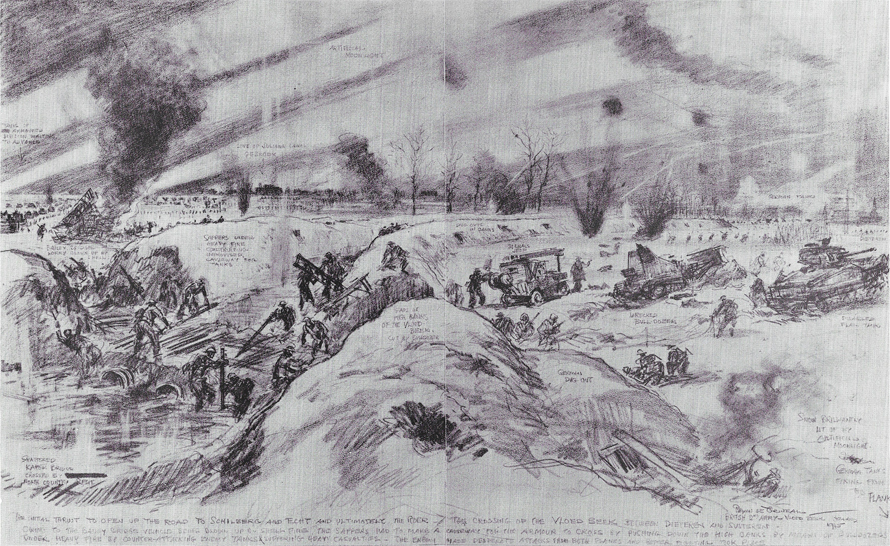 Tekening oversteek Vloedgraaf door: Bryan de Grineau 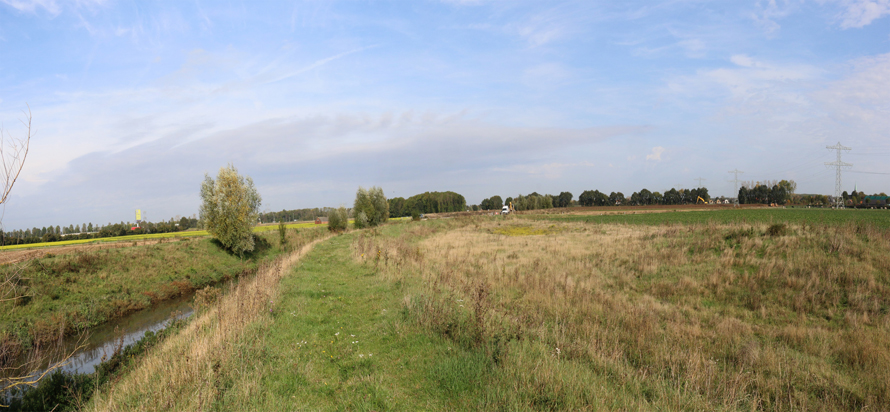 Ongeveer zelfde locatie anno 2019 We moved off (from Stadtbroek near Sittard on the 16th) on ice-covered roads and in a thick fog which held up the attack and gave us time to whitewash our tanks as some sort of camouflage. With the daylight (on the 17th) came a thaw which though slight turned the tracks to quagmire. Slowly we made our way forward but the main advance down the centre got bogged down. All through the late afternoon we sat near a stream which the engineers and Pioneer Corps were trying to bridge under constant mortar and shell fire. In the Susteren battle 1st RTR lost seven tanks to Bazooka teams and A/Tank guns. Despite the savage Susteren battle, the 11th Hussars had put a patrol into Oud Roosteren, which was later captured by 6th KOSB under command from 52nd Lowland Division. Lieutenant Alan Parks, with ‘C’ Squadron 1st RTR, wrote: ‘My orders were to take my troop and capture the small village of Heide, just NE of Susteren, across a railway line as ‘A’ and ‘B’ Sqns were moving north to Echt and Schilberg.’ Later C Squadron 1st RTR with the 2nd Devons and flame-throwing Crocodile Churchill tanks, pushed north to capture Ophoven and the western sector of Echt, taking 100 prisoners. The historian of the Devons described the operation: In thaw and thick fog at 1630 hrs on Jan 17th, the dyke bridges came under heavy shellfire which delayed the tanks. When they got across our carriers had to be hitched to them. In the snow, slush, sniping, across minefields and despite MG and 75mm fire the two columns moved off. Each column consisted of a mobile screen of two troops of 1 RTR tanks, a section of bren gun carriers, a section of assault Pioneers, then 2 more troops of tanks, our infantry company in (armoured) Kangaroos, a section of Norfolk Yeomanry SP A/Tk guns, a section of 3 in mortars, a 6 pdr A/Tk section, a RE recce party and the RHA FOO. Major Overton took D Coy on the left route towards Echt, and Major Howard took C Coy on the right towards Schilberg. In the villages Nazi slogans were painted on the walls, ‘We will never capitulate.’ | ||||||||||||||||||||||||||||||||||||||||||||||||||||||||||||||||||||||||||||||||||||||||||||||||||||||||||||||||||||||||||||||||||||||||||||||||||||||||||||||||||||||||||||||||||||||||||||||||||||||||||||||||||||||||||||||||||||||||||||||||||||||||||||||||||||||||||||||||||||||||||||||||||||||||||||||||||||||||||||||||||||||||||||||||||||||||||||||||||||||||||||||||||||||||||||||||||||||||||||||||||||||||||||||||||||||||||||||||||||||||||||||||||||||||||||||||||||||||||||||||||||||||||||||||||||||||||||||||||||||||||||||||||||||||||||||||||||||||||||||||||||||||||||||||||||||||||||||||||||||||||||||||||||||||||||||||||||||||||||||||||||||||||||||||||||||||||||||||||||||||||||||||||||||||||||||||||||||||||||||||||||||||||||||||||||||||||||||||||